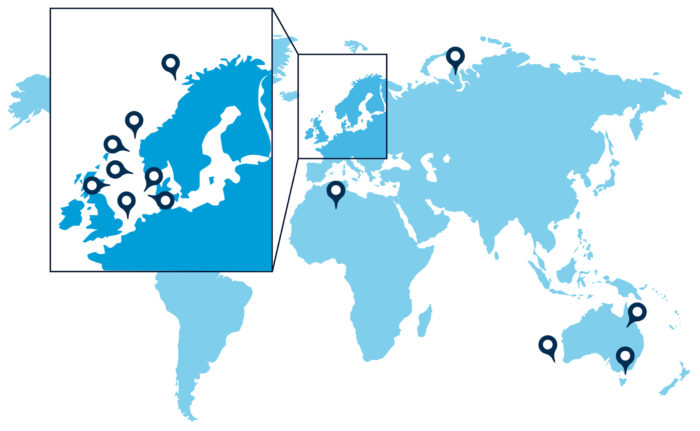World leading expertise supporting Carbon Storage projects
Over more than two decades, AGR has been engaged by authorities, energy companies and certification agencies to develop and implement CO2 storage (carbon storage) strategies for on- and offshore worldwide. This work has been a very interesting journey, generating optimism that a huge amount of CO2 may be stored. This is also reflected in the European Union Report “EU Geological CO2 Storage Summary report”.
However as yet, the capturing of CO2 from major emission points is still in its infancy, and a costly development of technology is to be expected.
There are many valid concepts for CO2 storage that meet human health requirements and the long-term confidence of containment.
The short version is when dense phase CO2 is pumped into a porous saline aquifer below sufficient depth (800 m+) that will allow the CO2 to remain away from the atmosphere. Over time, the CO2, which has not been dissolved in the aquifer water or trapped in pores, will move upwards (since the dense CO2 phase is more buoyant than water) along permeable conduits/reservoirs until it is capped by a geological seal. It is a great benefit if the movement of the CO2 plume can be monitored by seismic.
In the long-term, CO2 will be dissolved and may react with minerals in the host rock to reach a solid state.
Our experts highlight just a handful of the risks that must be assessed as part of an due diligence process for evaluation of carbon storage facility.
Screening for CO2 storage
When screening for CO2 storage, the distance to CO2 capture locations is important. Cost benefit will also play an important role as always. While it may be tempting to store CO2 in a drilled location, where geology is well understood, legacy wells, however, also pose a threat of overburden integrity and containment. Usually, CO2 storage requires the use of seismic to create a 3D model of the potential reservoir. Depending on the geology, 2D or most likely 3D will be necessary before any qualified reservoir can be determined. Well control and good well data will also be required before qualifying a reservoir.
Qualification of CO2 storage
Qualification of the CO2 storage site is a thorough process. It addresses a number of aspects:
- Reservoir description
A key parameter of a CO2 storage project is capacity in terms of injectivity at well location and pore space volume. A thorough reservoir description that includes both sedimentological and petrological characterization is therefore needed to fully analyze the CO2 storage. Sedimentology will allow for the geometrical description of porous and impermeable stratigraphy, to be used for reservoir simulation of plume movements. Faults will also contribute to the tortuosity of CO2 movements and, if open, faults will create conduits of flow rather than barriers. To fully model the reservoir, similar to oil and gas, a complete model encompassing the span of uncertainties and high, base and low case reservoir description are required.
- Pore Pressures
Pore Pressures in the sequences in a basin tells us something about the possible containment of CO2, as often we see increasing overpressure above hydrostatic as a function of depth. In order to have overpressure you need a barrier, and in order to understand the pressure differentials with depth means that the extent of the barriers and their integrity will be a key factor in a reservoir model. Usually CO2 injection does not generate great overpressure, in most cases less than 5 Bar at injection point. However, if CO2 is allowed to accumulate and build a column, then overpressure as a consequence of buoyancy will result. Barrier formation strength needs to be well in excess of any foreseeable over-pressure.
- Tectonic activity
This must be understood, both in terms of fault movement and tectonic forces. Seismic activity as part of a long-term perspective is important to quantify and predict the risk of intermittent loss of seal capacity in faults. CO2 storage is subject to a 1000-year containment risk, and tectonic forces in terms of maximum and minimum horizontal stress and fracture integrity require a geomechanical analysis both in 1D and 3D.
- The Dynamics
The dynamics of fluid flow, simulating injection, plume movement and trapping of CO2 can be done if seismic data and subsurface characteristics are adequate. Existing reservoir simulation tools and new special tools for CO2 simulation will enable the prediction of CO2 plume movement in the short- and long-term. The simulations represent an important tool to evaluate the uncertainty and risk related to containment of the injected CO2. Experience from existing CO2 injection programmes have shown that great confidence is achieved through monitoring CO2 plume movement.
Risks of CO2 storage – failure of containment – economic failure
Legacy wells are defined as a key risk for the containment of CO2. It is well known that many (may be most) P&A wells are leaking gas and oil to the surface, offshore this is easy to detect by way of bubbling well locations. Over time the reaction between CO2 and cement may alter the properties of cement. In addition, CO2 is likely to cause corrosion of casings and possibly generate conduits. Usually, wells are plugged and abandoned with the aim of preventing hydrocarbons leaking out of reservoirs. The plugs are set to seal hydrocarbons according to oil and gas standards at the time of P&A. The evaluation of legacy well integrity becomes more uncertain with age, due to the lack of documentation and low-quality log data. Therefore, the number of wells, the age of wells and legislation/practices at the time of the P&A, all contribute to legacy well risk.
CO2 invasion of hydrocarbon bearing intervals is also an issue of concern. In some cases, CO2 is stored in reservoirs next to oil and gas fields, by virtue of existing infrastructure and geological well and seismic data. In some cases, CO2 may be used for displacing oil and for achieving better recovery in a field. In several projects we have worked on, there is a risk of CO2 migrating into oil and gas reservoirs.
Monitoring CO2 plume migration will control such events. It is a strategic choice whether to store CO2 in a trap, similar to an oil and gas accumulation, or to allow the CO2 to percolate a saline aquifer. In the latter case, the risk of top seal failure is less, compared to the accumulation of a CO2 column that builds overpressure by buoyancy. Also, the risk of CO2 invasion in water resources, thereby preventing such water resources being used for irrigation, industrial and humans, is a great concern. Finally, CO2 leakage into the atmosphere is a total failure and can be lethal to public health.
Fault leakage is somewhat ill predicted. To fully characterize the risk of fault leakage, fault history and tectonic stress need to be taken into consideration. Seismic will give a history of fault movements, whereas geomechanical modelling will enable characterization of seal capacity.
Tectonic events may cause massive leaks, in particular if CO2 is stored as an accumulation in an untested structure. Storage in a depleted field on the other hand would be less risky in a way since the containment has been tested. However again, legacy wells will impose a risk.
Judicial considerations; most countries have regulations and targets to meet the Paris accords of reducing CO2 emissions, thus the transport of CO2 across borders may not be simple. Judicial questions on how to treat CO2 as “garbage” need to be understood and agreed before the transport across borders takes place. The lack of a legislative framework could pose an economic risk as most CO2 emissions capture and storage are driven by authorities to meet emission reduction targets, so when CO2 is shipped across borders, who is to take credit and meet governmental CO2 emission goals?
There is an international standard (ISO 27914), which describes the procedures for screening, qualification and certification of CO2 storage. This is a comprehensive set of aspects and topics to be followed as a prerequisite for the issuing of a certificate of operations. Each phase of CO2 storage site; screening, selection and characterization/qualification is subject to a certificate being issued.
To learn more about our Carbon Storage capabilities and discuss your exact requirements, please contact us. We would be delighted to hear from you.




